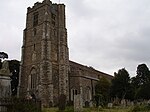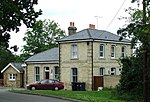Barrington Hall, Essex
Barrington familyCountry houses in EssexGrade II* listed buildings in EssexHatfield Broad Oak

Barrington Hall is a Grade II* listed 18th-century English country house in Hatfield Broad Oak, Essex, England. Barrington Hall is built in red brick, in both two and three storeys, with a balustraded parapet and a number of ornamentally shaped Dutch gables. The south front of the house has a central block centrepiece with carved figures. It was Grade II* listed in 1975, its listing stating: "c.1734 and mid C19. Of red brick with stone dressings and rusticated stone quoins."
Excerpt from the Wikipedia article Barrington Hall, Essex (License: CC BY-SA 3.0, Authors, Images).Barrington Hall, Essex
Barrington Hall, Uttlesford Hatfield Broad Oak
Geographical coordinates (GPS) Address Nearby Places Show on map
Geographical coordinates (GPS)
| Latitude | Longitude |
|---|---|
| N 51.8359 ° | E 0.2479 ° |
Address
Barrington Hall
Barrington Hall
CM22 7JL Uttlesford, Hatfield Broad Oak
England, United Kingdom
Open on Google Maps








